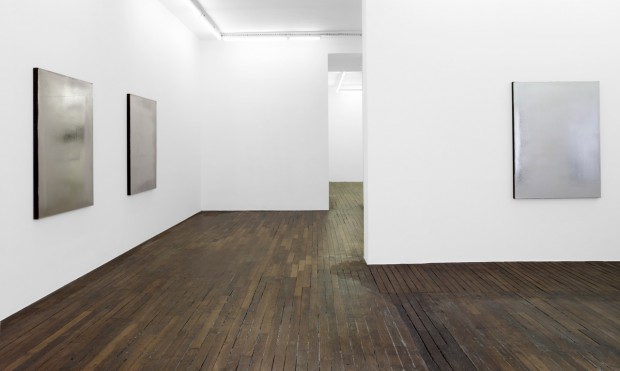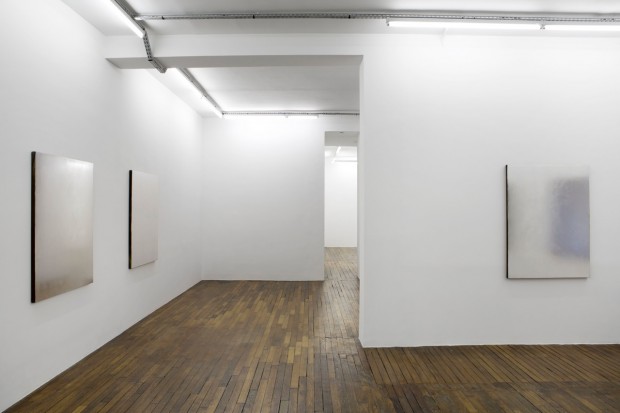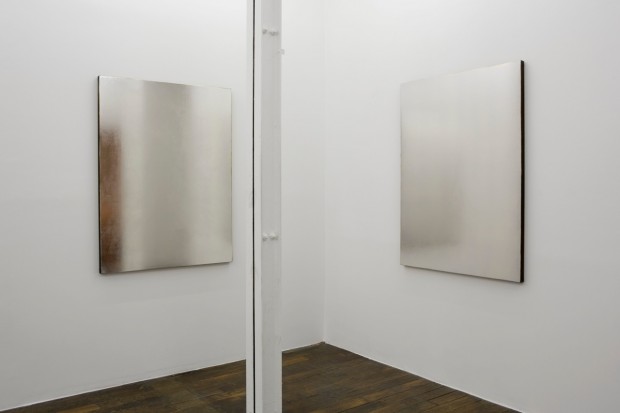
Exhibition view, Jacob Kassay, Art:Concept, Paris, May 8th to June 5th 2010 Courtesy Art : Concept, Paris - Photo : Fabrice Gousset

Exhibition view, Jacob Kassay, Art:Concept, Paris, February 23rd to April 6th 2013 Courtesy Art : Concept, Paris - Photo : Guillaume Ziccarelli
First, let me confess: I’ve never seen a painting by Jacob Kassay.
I’ve never seen the silver electroplated canvases that supposedly owe a debt to 19th-century photographic practices and have been compared to the monochromes of Robert Ryman and Yves Klein. These paintings have fetched upwards of $250,000 at auction, turning 29 year-old Kassay into an art-world darling.
After traveling to Paris for his latest show at Art : Concept, I still haven’t seen a Kassay painting.
I saw props in lieu of paintings. On view are eight 36 x 48-inch silver canvases, identical in size and installation to the paintings that were presented at Kassay’s 2010 Art : Concept show. As with his paintings, the canvases were first coated with gesso and then turned over to a professional who electroplated them before applying a thin layer of silver (a process similar to how mirrors are made). Kassay’s subsequent working of his silvered canvases is said to be minimal, but this time the artist did not touch the surfaces at all.
I can’t compare these stand-ins to the paintings in Kassay’s previous exhibition. According to the gallery, the 2010 paintings have more incidental markings, but the surfaces of the current objects are uniform – hence more reflective – than the “real” paintings. And this time, they are not for sale: once the exhibition is over, the canvases will be destroyed and the stretcher bars recycled.
Lacking marks that could be gestural, the metallic objects reflect my body as a dark, blurred shape. I see myself straining to see. Kassay sets up a situation in which his paintings are present only through their staged absence. They are a memory, perhaps, for some viewers and nothing more than a blur in photographs. (Kassay’s paintings do not reproduce well.)

Exhibition view Jacob Kassay, Art:Concept, Paris, May 8th to June 5th 2010 Courtesy Art : Concept, Paris - Photo : Fabrice Gousset

Exhibition view Jacob Kassay, Art:Concept, Paris, February 23rd to April 6th 2013 Courtesy Art : Concept, Paris - Photo : Guillaume Ziccarelli
Art : Concept’s 2010 exhibition happened before Kassay’s market success, and this 2013 repetition appears to be the artist’s attempt to engage with the theater of the art world and the conditions under which it is possible to see “a painting by Jacob Kassay.
The exhibition is trying to be critical – I don’t question the earnestness of the gesture – but I don’t think Kassay’s repetition works. For all the reflective surfaces, the exhibition strikes me as deflective: replacing “painting” with “mirror” is a refusal or an evasion that stands in for criticality. The exhibition is not reflective in other than the most literal way. (Sometimes a mirror is just a mirror.)
The fact that Kassay’s mirror objects are emphatically “not paintings” and earmarked for destruction implies that the definition of what counts as a “Kassay painting” has to do with its entry into the art market. If so, then it is an irony that the artist’s attempt to evade the market in fact reaffirms its powers even to name what counts as “a painting by Jacob Kassay.”


Comments on this entry are closed.